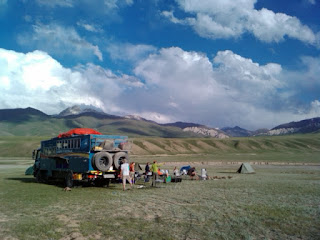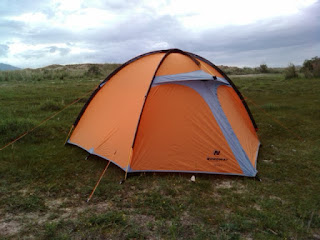official trip finished in Singapore, or more properly Darwin, and
Borneo is an optional extra. So far we've seen some cool things here,
and some rubbish things: I will relate accordingly.
Our first stop was Kuching for one night, just to catch our breath
before heading to Bako National Park by minibus and boat: the park is
inaccessible by road. This park is famous for being one of the few
places left in the world where Proboscis Monkeys still exist in the
wild, there are about 1000 left. I wasn't aware of this initially, as
we set off on a jungle trek to the nearest beach. Just fifteen minutes
later we saw a family of PMs in the trees above us, maybe half a dozen
jumping and swinging past, stopping to eat as they went. They are
quite gentle and reserved for monkeys, no poo throwing here. A short
while later they went on, and so did we. I found out later that it was
quite lucky for us to see them so easily and quickly, and later still
I found out how endangered they are. Very beautiful and unfortunately
very rare creatures.
We carried on walking through the jungle, and my God, it was hot!
There was no wind, and the humidity must have been close to 100%.
After no more than ten minutes my clothes were soaked in sweat and I
was being bitten alive by insects, even with mozzie repellent on. The
problem with mozzie repellent in the jungle is that you sweat so much,
most of it comes off. The only way I found to minimise the bites was
to keep moving, easier said than done when you are exhausted and
dehydrated. Our 800m walk to the beach took an hour, the terrain was
so difficult, and another hour to get back. And my water ran out just
after we started back. Not a good situation, but it was only an hour.
Despite this, it was a good walk because we saw the PMs.
The long-tailed macaques are a totally different kettle of fish
though: aggressive, sneaky thieves. They will run up and take any
unattended food or drink, try to break into your room and they
threaten you if you get too close to them. Typically, they aren't
endangered.
One thing you notice about the jungle is that there are no locals in
it. They all know it is hot and buggy and stay out of it, or chop it
down. Only weird foreigners go into the jungle for a walk. I now
understand exactly why there is a deforestation issue on Borneo: it is
horrible to live in the jungle.
After Bako, we came back to Kuching for two nights, quite nice but
oddly sleepy for a town of its size. There is an old quarter, now the
Chinese district, dating from the colonial days, and a beautiful brand
new government building which elicits resentment from the locals who,
understandably, feel that the money could have been better spent.
Whilst here we went to the Semenggoh orangutan sanctuary, along with
every tourist in the area. Even though it was busy with people, it
also turned out to be busy with orangutans as well, young ones, mums
with their babies and even the notoriously tourist-shy alpha male of
the sanctuary: Ritchie. It was amazing to see so many orangutans in
one place, and they are even more endearing in real life than on TV.
Ritchie was something else though: 140kg, suspicious and in full
control of the situation. He knew that he was the king of all he
surveyed, including all us tourists.
Our next port of call was Bintulu, via Sibu. This involved a very long
day's travel by minibus, boat, local bus, and taxi, and we stayed
there for two nights. Our hotel seemed to cater more for the per hour
clientele than the per night ones, so in retrospect it is maybe not
surprising that our room had cockroaches living in it. We were moved
in the second night to another room, which also had cockroaches, but
this time my bed also had bed bugs. Their bites are really itchy, so
much so that you wake up, and obviously don't want to go back to
sleep. Rubbish.
We did go to Similajau National Park whilst there, and went trekking
through the jungle for 14km. This was actually easier than the 1.6km
we did in Bako NP, as it wasn't so stifling or as buggy in that
jungle. Of course all my clothes were still soaked through, and I
still got bitten a few times. The trek was to Turtle Beach 1, which as
the name suggests, was definitely meant to be full of turtles! We,
however, saw none. A picnic partially made up for the distinct lack of
turtle action.
One of the nights we spent in Bintulu was a Saturday, and it would
have been rude not to partake of the parties. So after watching
Notting Hill on the TV, Denis and I went to some bars. We weren't the
only Westerners in the village but I only saw one other the whole
time. Some of the bars were a bit poor, notably the Paradise Cafe, but
Casablanca Bar and Lounge more than made up for it. This was obviously
the place to be on a Saturday in Bintulu, with an excellent local band
and a happy crowd. Denis had a dance-off with a local dude and showed
the appreciative audience how they roll in Irishland.
Following the highs and lows of Bintulu it was onwards to Niah
National Park. This park has a huge cave system which is home to
millions of bats and swiftlets, and of course, tons of bat and
swiftlet poo. Very cool to walk through the caves and we even came
across some locals harvesting the swiftlet's nests for birds nest
soup. To do this they climb poles to the cave roof, these poles can be
up to maybe 50m high, and they hold 3m long poles with baskets on the
end which they use to poke the nests off the cave walls. Naturally, no
safety equipment of any kind was in evidence. For those who don't
know, swiftlet nests are made entirely from the birds' saliva,
allowed to dry. Whoever first thought about eating them must have been
very hungry and very agile.
We are now going to Brunei, home of the famous sultan, via the town of
Miri. One more stamp in the passport!
Pics are the cave entrance at Niah, Denis appreciating Alex's moves,
Turtle Beach 1 sans turtles but with Debbie, Kuching skyline with town
hall, and as close to an orangutan as my phone's camera can get.




















































